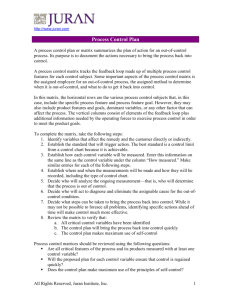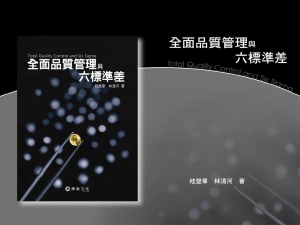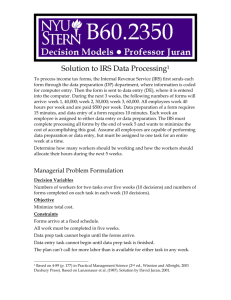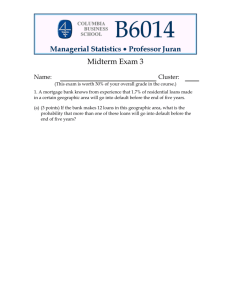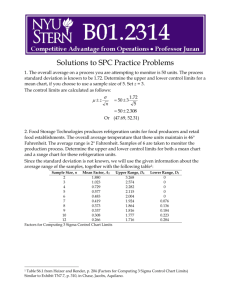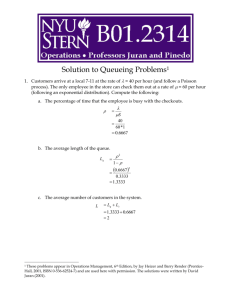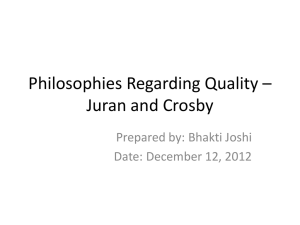Decision, Risk & Operations Working Papers Series Juran's
advertisement
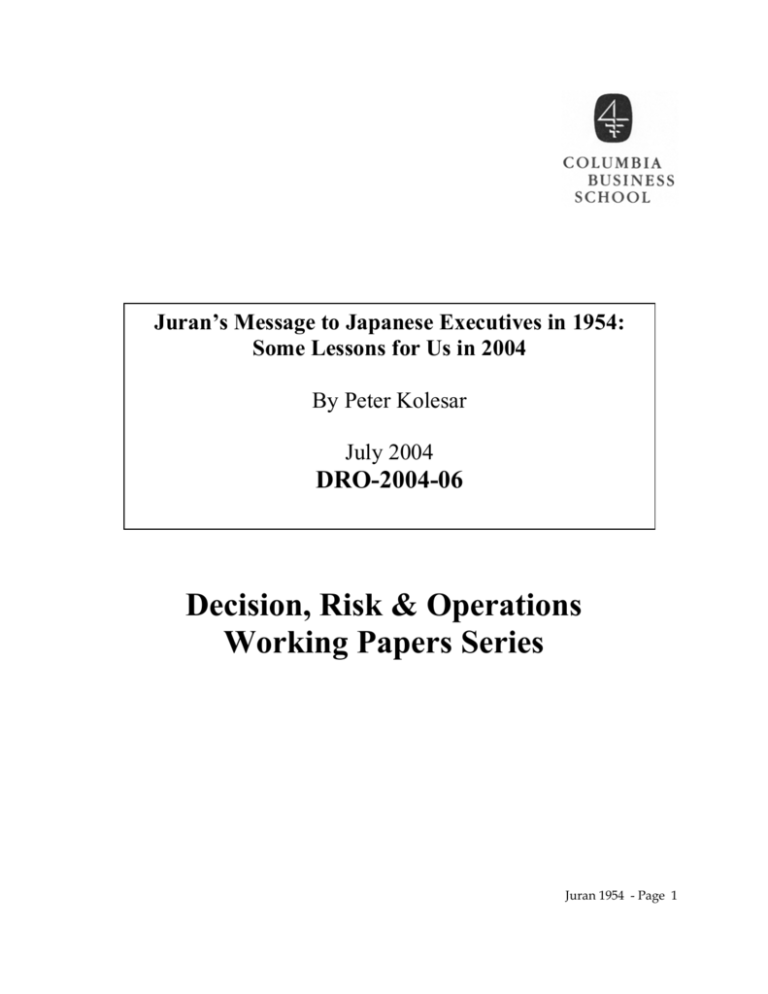
Juran’s Message to Japanese Executives in 1954: Some Lessons for Us in 2004 By Peter Kolesar July 2004 DRO-2004-06 Decision, Risk & Operations Working Papers Series Juran 1954 - Page 1 Juran’s Message to Japanese Executives in 1954: Some Lessons for Us in 2004 Peter J. Kolesar Columbia University July 2004 INTRODUCTION The quality management movement has reached a state of maturity that invites reflection about where we are and where we should be going. We ask, “What are the real strengths and weaknesses of approaches as diverse as the Baldrige frame-work, ISO 9000 and Six Sigma?” Aware of the faddish aspects of past initiatives like Quality Circles, Benchmarking, and Business Process Re-Engineering, we seek enduring concepts and approaches. In this centenary year of birth that master of quality, Joseph Juran, it is appropriate to look back at his work for guidance. Because this is the also 50th anniversary of the legendary lectures on quality management that he gave to Japanese industry, this article re-examines the message that Juran brought to Japanese executives in 1954. Perhaps we can find there, in the words of Juran, himself, some “lessons to be learned.” It is the conventional wisdom that in the 1950s Americans taught the Japanese quality control, which they actually implemented and then improved on our home-grown but neglected concepts. Then, in the 1980s “we” re-imported the refined quality control concepts from “them” and further developed and expanded the concepts and techniques ourselves in the 1990s. However, it has never been clear exactly what the Americans originally brought to Japan. This article comes out of my own attempts to better understand the contributions to of the American quality experts in Japan in the post war years. There were three main contributions: First, the courses of the Civil Communications Section of the Allied occupation forces that were given to representatives of the Japanese electronics industry in the immediate post wars years. Second, the famous1950 statistical quality control lectures of W. Edwards Deming, and finally the 1954 quality management lectures of Joseph M. Juran. The alleged contributions of Deming and Juran to the Juran 1954 - Page 2 start of the Japanese quality movement have attained the status of myth. In an earlier article I wrote about what W. Edwards seeming actually taught the Japanese in 1950. In the summer of 1954 Joseph Juran gave two series of lectures on quality management to Japanese senior and midlevel managers which have been widely acknowledged as being influential in the development of Japanese industry’s implementation of quality control. But, beyond typically brief acknowledgments only a few facts are available in print about what Juran exactly did in Japan. Butman, in his 1997 biography of Juran, and Juran, himself, in his recent autobiography Architect of Quality, both give highlights of Juran’s 5 weeks in Japan. Although particulars have not been publicly available, it is clear that the Japanese have long felt that Juran’s influence was very significant. Kaoru Ishikawa, who assisted during Juran’s 1954 lectures and who was himself perhaps the most significant innovator in the Japanese quality management movement, has expressed his feelings about the significance of Juran’s message when he wrote, “To help solve the problem [of an over emphasis on statistical methods] Dr. J.M. Juran was invited to Japan in 1954 to give a seminar for executives and department section managers. Quality control at last started to be used as a management tool.” Junji Noguchi, who was the long time executive director of the Union of Japanese Scientists and Engineers (JUSE) was very candid in his remarks to this author during a 1987 interview that he considered Juran’s contribution second to none. Mr. Noguchi also confirmed to me that JUSE had offered to name the Japan Quality Award, the follow-up award that can only be won by Deming Prize winners, after Dr. Juran, but that he declined the honor. Dr. Juran has himself been reluctant to make great claims regarding his impact in Japan. In print he opined that, had he and Deming never been to Japan, the Japanese would have made the same progress. Nevertheless, the Japanese invited him back for another extensive series of lectures in 1960 -- and a dozen times subsequently to lecture on special topics. Over the years a stream of Japanese visitors would make Juran’s office a stopping point on their tours of the United States. And, in May 2004, at the celebration of Dr. Juran’s centenary year the distinguished Japanese quality leader Professor Noriaki Kano made a point of traveling to Stamford Connecticut to honor Dr Juran. Juran 1954 - Page 3 A JUDGEMENT To clarify Juran’s specific contribution to the Japanese quality movement and to shed light on the particulars of the message that he brought to Japan, I examined the actual content of Juran’s 1954 lectures. This detailed review leads me to conclude that Dr Juran is wrong in his modest assessment of his impact. His lectures are astounding in their thoroughness, comprehensiveness and forward looking concepts they contain. Moreover, the nature of the many questions put to him by the Japanese participants reveals the relatively naïve state of their own thinking and approaches at that time. The specificity of responses and advice that Juran was able to give to their detailed questions is remarkable. The audience was large and influential. JUSE took great pains to follow-up. In short, Dr. Juran’s 1954 lectures were a major accelerating factor in the progress of Japanese industry’s quality progress. More importantly, his lectures to senior managers contain a clear set of imperatives that if followed will position an enterprise for quality improvement. They are still relevant in 2004. BACKGROUND Juran’s 1954 lectures were a direct result of his publication in 1951 of the seminal Quality Control Handbook. JUSE’s mission in inviting Dr. Juran was to have him address the imbalance and over emphasis on statistical methods and control charts that they saw in Japanese quality efforts. Juran’s career to that point prepared him perfectly for the job that JUSE had put before him. The foundation was built during his long employment at the Hawthorne Works of AT&T which he had joined in 1924. At Hawthorne, Juran moved steadily up through the management ranks holding a variety of staff positions related to quality -- culminating in his appointment as Corporate Chief Industrial Engineer of Western Electric in 1941. At the end of the war Juran went into private practice as a management consultant and for a time he served as chairman of the Industrial Engineering Department at New York University. Juran’s writings from the 1940s and 1950s give evidence of his broad managerial interests and his particular searching inquiries into the problems of quality management. Juran 1954 - Page 4 In the period between July 3rd to August 17th, 1954, Juran gave two renditions of a two-part lecture series. The first part, for senior mangers, mostly CEOs, was two days in duration, while the part for mid-level managers was ten days long. The programs were given first near Tokyo and then near Osaka. Some 124 senior managers and 266 middle managers attended. The program for middle managers was designed so that Dr. Juran lectured for half the day and during the other half, while the participants were in workshops, he visited numerous factories. Among the companies he visited were Nippon Kogaku (Nikon) and Tokyo Shibaura (Toshiba.) In advance of his trip Juran prepared detailed lecture notes in English. These ran to some 265 pages and JUSE had the notes translated into Japanese. Each participant received a copy in advance and was expected to have read them before the lectures themselves. The left face of each double page in the book contained the English original and the facing right page the Japanese translation. This document is the key source for this article. In delivering the actual lectures Juran did not so much follow the script as to comment on and augment his text with additional case histories, examples and side comments. JUSE staff took verbatim notes of the proceedings which were translated into Japanese and in 1956 JUSE published the full text of the lectures -- including both the prepared text and the additional comments in Japanese only. As Dr. Juran did not keep an English language version of his spontaneous comments I have, with the assistance of my Japanese students at Columbia Business School, re-translated these back into English THE SENIOR MANAGEMENT LECTURES This article focuses on the specifics of Dr. Juran’s Senior Management Lectures. Dr. Juran’s explicit mission in this two day session was to give the Japan’s most senior executives a clear view of their role in managing for quality. It had been noted by the Japanese experts who invited Juran that, despite the emphasis of the CCS course on management‘s responsibilities and despite Deming’s special lectures to some 150 senior mangers on their responsibility to lead the quality efforts, that Japanese industry had fallen into an excessive emphasis on statistical methods and that senior managers gave quality issues little of their personal attention. It was the managerial content of Juran’s 1951 Quality Control Handbook that had attracted JUSE. Juran 1954 - Page 5 The theme of the executive program was the responsibilities of the top executive in controlling [that is, in managing] quality. As I shall clarify below, Juran’s 1954 utilization of the word “control” would I think be better captured today by the word “manage.” Juran laid five primary areas of responsibility: • Responsibility for high policy or doctrine on quality • Responsibility for choice of quality of design ( grade) • Responsibility for the plan of organization of the company with respect to quality • Responsibility for setting up the measurement of what is actually taking place with respect to quality • Responsibility for reviewing results against goals and for taking action on significant variations Let’s look at the most vital of the points that Juran made within these categories. Issue one, the responsibility for high policy or doctrine, was seen by Juran as a set of ethical issues that he poses with three challenging questions: • Will the enterprise truthfully represent its products when offering them for sale? • Will the enterprise sincerely take steps to make its products to the contract provisions? • Will the enterprise, in case of quality failures, acknowledge them and sincerely meet its obligations under the contract? Juran clarifies the executive’s responsibilities: “Their responsibility is not only to decide these things, and to make their decisions known throughout the enterprise; it is equally their responsibility to show by repeated acts that they themselves truly follow the principles they have enunciated. On issue number two, the responsibility for choice of quality of design (grade) Juran stated that “It is axiomatic that if the enterprise is determined to remain in business for a long period of Juran 1954 - Page 6 time, the quality of the product or the service which it is selling must be adequate to meet the needs of the consumer. Failing this the consumer justifiably will turn to other, competing products or services which do meet [his] needs.” Design quality is seen by Juran as a fundamental, as a strategic choice of the markets to be served and pricing structure employed. He was categorical: The senior executive must be the decision maker on these issues. With respect to defining quality Juran clarified that while higher quality grade usually costs more, conformance to the design usually costs less. His next point is one that companies seem to still struggle with -- integration of the views of all impacted parties to new product design. He suggests that all affected departments like R&D, production, procurement , marketing and so forth should participate in the choice of design quality -- and that this is best done via a standing “New Products Committee” reporting to and advising the CEO, the decision–maker. He is adamant that this participation not be left to chance, but must be organized by the chief executive. While today we might not wish to execute via such a standing committee, Juran’s point of insisting on integration of the design process is today broadly accepted -- though not always implemented. On issue three, responsibility for the plan of organization of the company with respect to quality, Juran offered a model with a line Quality Department that is part of manufacturing and which includes functions related to inspections ( incoming, in-process, outgoing), measurements and instrumentation, quality assurance, quality control, defect prevention, and statistical analysis.. In addition he called for a standing “Quality Committee” whose functions included the identification of unsolved and chronic quality problems, the identification of and recommendation of solutions to these problems and monitoring progress. The latter being what Juran himself would later call “holding the gains.” This standing quality committee was an embryonic form of what Juran would later call the “Quality Council.” As previously described he also called for a “New Products Committee” to unify and assemble the views of the affected department on new product design issues. As part Juran 1954 - Page 7 of the quality infrastructure Juran also laid out the structure of a “Defect Prevention Program” the components of which included: • Computation of quality costs and losses • Identification of where quality losses are concentrated • Estimates of how much of the loss can be eliminated economically • Estimate the budget required to do so • Fact finding to discover causes of principal chronic defects • An improvement quota for line departments, set by agreement with them • A time-table • A plan for action and definition of responsibilities • A plan of communication to enlist cooperation of all employees and supervisors • A system of scorekeeping • A plan for coordination of the program and review of results • Appropriate training for top executives and for both line and staff groups On issue four, responsibility for setting up the measurement of what is actually taking place with respect to quality, Juran offers a succinct, yet rich set of recommended measures. (It is remarkable that today many firms still struggle with what their quality metrics should be.) In these 1954 lectures Juran suggested a set of “essential” measures of quality including: • Share of market • Complaint rates • Costs of customer adjustments • Direct outgoing (physical) quality characteristics and defect rates • Costs of quality • Scrap, rework etc • Overhead and hidden factory costs • Delays and upsets • Lost goodwill • Reduced morale Juran 1954 - Page 8 On the last of his issues, responsibility for reviewing results against goals and for taking action on significant variations, Juran argued that “…the issue is to meet this responsibility through a scheduled, constructive review of results rather than through letting matters take their course until some serious difficulty arises.” In his view, such a review, to be effective would require a plan for the quality function and standards of performance be in place; that measures of actual performance against the standards be available and that management regularly undertake analysis of significant departures from standards to determine causes. Juran realized that while CEOs can request or command subordinates to act on a quality agenda, effective implementation is not automatic. He examines the conditions that are conducive to obtaining subordinates action, speculating that the probability of subordinate’s action is related to whether they know what their performance is supposed to be, and what the standards are; whether they know what their performance actually is, and the extent to which the system’s performance is truly under their regulation and control. The probability of action is enhanced by extent to which the subordinate participated in the establishment of the standard in the first place; feels that the standard is reasonable; and is convinced that the measures report actual performance. It is also critical that the subordinate is convinced that meeting this standard is important in relation to other demands made on him and is morally convinced that the standard should be met not just because the hierarchy demands it , but because it is in the best interests of his fellow human beings. Before concluding, let’s discuss Juran’s opening discussion in these 1954 lectures of the concept of “control.” “Control is the totality of means by which we establish and achieve standards.” He then substitutes into this formulation “quality control” and “statistical quality control” in an obvious manner. This definition is broad, but when Juran goes into detail about his “Cycle of Control” we see the richness, the managerial flavor of the concept he is working with. Juran’s cycle of control has the elements/steps: • Pick the objective • Develop a plan for achieving it Juran 1954 - Page 9 • To carry out the plan • Provide the resources • Assign responsibilities • Those responsible execute the plan • Controlling: Determine if the plan is being met: • Selection of control points • Definition of measures and a method of measuring • Selection of performance standards • Interpretation of the difference between actual and standard • Decision of action to take and implementation This is a very rich and detailed structure, quite managerial in scope. For some time I have been interested in the origins of the famous PDCA or PDSA cycle, attributed by many to Deming, who himself acknowledged Shewhart and said that he had taught it his 1950 lectures in Japan. However, the Shewhart cycle deals with product design, not problem solving and it appeared to me that someone in Japan took the Deming/Shewhart cycle and made the PDCA process out of it. Professor Noriaki Kano and I speculated that the designer may have been Ishikawa or Mizuno. Perhaps we will never know who was the creator, but my examination of Dr Juran’s 1954 lecture notes suggests that his cycle of control may well have been amongst the stimuli that lead to PDCA. A CLOSING COMMENT: There have been many developments in the world of duality management in the 50 years since these lectures were given, yet they hold up well as advice to any executive looking to manage for improved quality. One might be tempted to say, Nike style, “JUST DO IT.” Juran 1954 - Page 10 References Butman, J., Juran : A Life time of Influence, Wiley, New York, 1997 Deming, W. E., Elementary Principles of the Statistical Control of Quality - Series of Lectures, Nippon Kagaku Gijutsu Remmei, Tokyo, Japan, 1951. Donaldson, P., “100 Years of Juran,” Quality progress, Vol 37, No. 5 May 2004, 25-39 Hopper, K., "Quality Japan and the US: The First Chapter," Quality Progress, September 1984, 34-41. Ishikawa, K., Introduction to Quality Control, 3A Corporation, Tokyo, 1990 (originally published in Japanese by JUSE, 3rd Edition, 1989).) Juran, J., Planning and Practices in Quality Control: Lectures in Quality Control - July and August 1954, (in English with Japanese translation by Ken-ichi Koyangi, JUSE, Tokyo, 1954. _________, Architect of Quality: The Autobiography of Dr. Joseph M, Juran, McGraw- Hill, New York, 2004. ______, "Made in USA: A Renaissance in Quality," Harvard Business Review, July-August 1993, 41-50. Kobayashi, K., "Quality Management at NEC Corporation," Quality Progress, April 1986, 18. Kolesar, P., "What Deming Told the Japanese in 1950," Quality Management Journal, Vol. 2, No. 1, Fall, 1994, 924. Nonaka, I., “The Recent History of Managing for Quality in Japan,” Chapter 16 in A History of Managing for Quality, J. Juran, editor, 517- 552. Juran 1954 - Page 11
